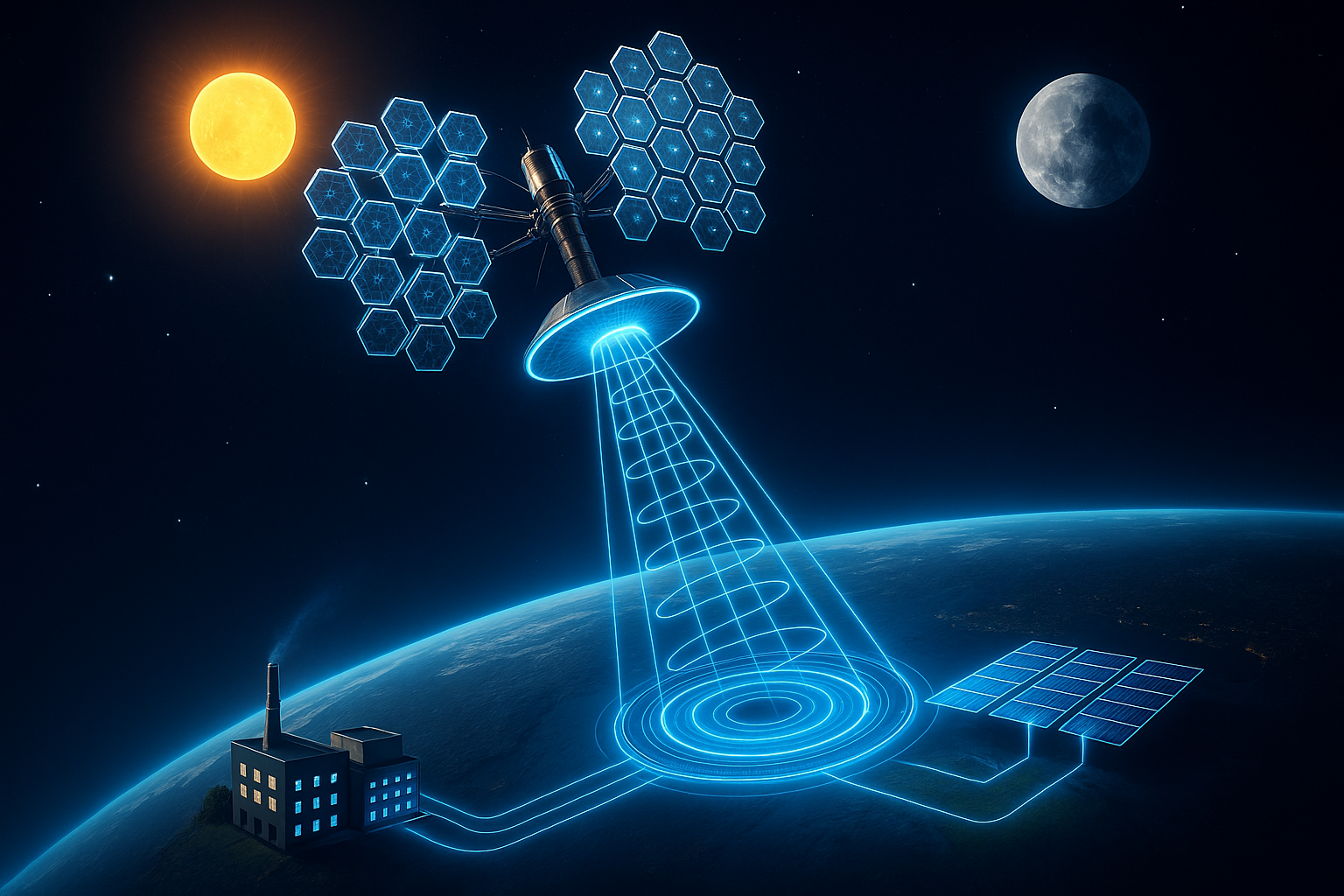Imagine a power plant that never sees a cloud, never experiences night, and can deliver clean, limitless energy to any point on Earth at the flick of a switch. For decades, this has been the stuff of science fiction. But in the quiet vacuum of space, this audacious concept is rapidly becoming an engineering reality. Last year, a small satellite launched by Caltech successfully collected solar power in orbit and, for the first time ever, beamed a detectable amount of that energy back to a receiver on the ground. The switch has been flipped. A new space race for the future of energy has begun.
The idea, known as Space-Based Solar Power (SBSP), is as simple in concept as it is staggering in scale. It involves placing massive solar arrays into orbit, often in a geostationary position where they can bask in uninterrupted sunlight 24 hours a day. Free from the filtering effects of the atmosphere, these panels would soak up solar radiation that is five to six times more intense than what reaches the ground. This captured energy is then converted into a microwave or laser beam and transmitted wirelessly to a receiving station, a “rectenna”, on Earth, providing a constant, reliable stream of clean electricity.
In a world grappling with the intermittency of terrestrial renewables, SBSP offers a tantalizing solution: a baseload power source that is immune to weather and the day-night cycle. It could function as a kind of global “green battery,” stabilizing national grids that are increasingly reliant on the fluctuating output of wind and solar farms. Furthermore, by steering the energy beam, a single satellite could power a remote desert city, an isolated island nation, or even a disaster zone where ground infrastructure has been destroyed, bypassing the need for vulnerable transmission lines.
This revolutionary potential has not gone unnoticed. Nations around the globe are now pouring resources and intellectual capital into making orbital power plants a reality, sparking a quiet but intense geopolitical competition.
China has perhaps the most ambitious public timeline, with its national program aiming to construct a gigawatt-class power station in orbit by 2040, enough to power a large city. Chinese experts see SBSP as a cornerstone of their strategy to achieve carbon neutrality and cement their leadership in the space economy.
The United States, after years of fluctuating interest, has re-entered the race with renewed vigor. The landmark Caltech experiment, funded by private philanthropy, proved that the core technology of wireless power beaming from space works. Now, the U.S. military is following close behind. The Air Force’s Arachne mission, slated for this year, aims to test modular “sandwich tiles” that convert solar energy to a radio frequency beam, with the goal of powering military forward bases from orbit. Congressional bills and Department of Energy interest signal a coordinated national push to field a prototype system within the next decade.
Across the Atlantic, the European Space Agency (ESA) is methodically laying the groundwork through its SOLARIS initiative. By the end of 2025, ESA will decide on a plan to build its own in-orbit demonstrator, drawing on competing designs from industrial giants like Thales Alenia Space. Meanwhile, Japan, a long-time pioneer in the field, is preparing to launch its OHISAMA satellite next year. This mission will be a critical first, attempting to beam a full kilowatt of power from low-Earth orbit to a ground array, a crucial step in validating the entire system. Even the United Kingdom is a serious contender, with studies suggesting SBSP could supply a quarter of its electricity demand by 2050 and government funding now flowing to university researchers.
But before we can plug our toasters into an orbital socket, a set of colossal engineering and logistical challenges must be overcome. The first is sheer scale. A single gigawatt-class station would require solar arrays spanning several square kilometers, a structure far larger than anything ever assembled in space. Launching these materials, even with the falling costs of reusable rockets, and then assembling them with remote robotics represents a monumental undertaking.
Then there is the beam itself. Converting electricity to microwaves and back again is an inefficient process, and the beam must be aimed with pinpoint accuracy over tens of thousands of kilometers. While the Caltech test successfully steered a beam without moving parts, scaling that technology up is a daunting task. Safety is another paramount concern, though perhaps a misunderstood one. The energy beam would be so diffuse at ground level that it would be no more dangerous than a strong radio signal; automatic shutdown systems would prevent any misaligned beams from reaching the ground. Still, international regulations and public acceptance will be key.
Finally, the infrastructure on Earth is just as massive. Each orbital power plant requires a rectenna stretching for many hectares, comparable in size to a large terrestrial solar farm.
Despite these hurdles, the momentum is undeniable. The convergence of cheaper launch access, advances in lightweight solar cells, and robotic assembly is transforming SBSP from a distant dream into a plausible long-term investment. Experts believe that while commercial, city-scale power from space is likely still decades away, perhaps in the 2030s or 2040s, the pathway is becoming clearer with each successful test.
The implications are world-changing. A global grid of orbiting power plants could break our reliance on fossil fuels, provide energy security for all nations, and create a multi-trillion-dollar industry that would dwarf existing space markets. We are witnessing the dawn of a new energy paradigm, one where humanity finally learns to harvest the sun’s full, unrelenting power, not just the fraction that filters down to the surface of our planet. The race is on, and the prize is nothing less than the future of energy on Earth.
Disclaimer: Important Legal and Regulatory Information
This report is for informational purposes only and should not be construed as financial, investment, legal, tax, or professional advice. The views expressed are purely analytical in nature and do not constitute financial guidance, investment recommendations, or a solicitation to buy, sell, or hold any financial instrument, including but not limited to commodities, securities, derivatives, or cryptocurrencies. No part of this publication should be relied upon for financial or investment decisions, and readers should consult a qualified financial advisor or regulated professional before making any decisions. Bretalon LTD is not authorized or regulated by the UK Financial Conduct Authority (FCA) or any other regulatory body and does not conduct activities requiring authorization under the Financial Services and Markets Act 2000 (FSMA), the FCA Handbook, or any equivalent legislation. We do not provide financial intermediation, investment services or portfolio management services. Any references to market conditions, asset performance, or financial trends are purely informational and nothing in this report should be interpreted as an offer, inducement, invitation, or recommendation to engage in any investment activity or transaction. Bretalon LTD and its affiliates accept no liability for any direct, indirect, incidental, consequential, or punitive damages arising from the use of, reliance on, or inability to use this report. No fiduciary duty, client-advisor relationship, or obligation is formed by accessing this publication, and the information herein is subject to change at any time without notice. External links and references included are for informational purposes only, and Bretalon LTD is not responsible for the content, accuracy, or availability of third-party sources. This report is the intellectual property of Bretalon LTD, and unauthorized reproduction, distribution, modification, resale, or commercial use is strictly prohibited. Limited personal, non-commercial use is permitted, but any unauthorized modifications or attributions are expressly forbidden. By accessing this report, you acknowledge and agree to these terms-if you do not accept them, you should disregard this publication in its entirety.



